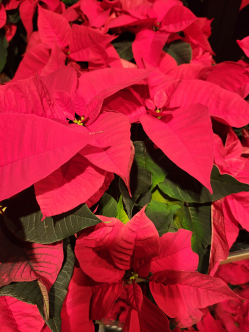Synonyms: Poinsettia, Star of Bethlehem, Christmas star flower, Euphorbia pulcherrima
Classification of toxicity: harmless to slightly toxic
In the vast majority of cases, swallowing small parts of the plant (green leaves, coloured bracts or plain blossoms) will not cause any symptoms or only mild gastrointestinal symptoms.
However, Tox Info Suisse are aware of serious and fatal outcomes in animals (dogs, cats) after consuming significant quantities of plant matter.
Poinsettia (Euphorbia pulcherrima; Euphorbiaceae family)
The poinsettia contains a white milky sap, which can irritate the skin and mucous membranes. Allergic reactions to the plant and its sap are also known.
In comparison with other plants in the spurge family (Euphorbiaceae), at least the commercial varieties do not appear to contain any highly irritating toxins (diterpenes) (more information here). However, non-toxic cultivated varieties are hard to tell apart visually from toxic plants.
Occurrence: In Switzerland, they are extremely popular houseplants during the winter and Advent period (pot plant). Originally from Mexico, this shrub has a woody stem.
Characteristics: The striking, star-shaped flowers with red, white and pink bracts are a distinguishing feature with the actual flowers inside quite plain. The dark-green leaves are lobed in shape. In its native environment, it grows as a perennial shrub and can reach a height of several metres.
What should you do in an emergency?
After swallowing small parts of the plant:
- Do not induce vomiting.
- Remove any plant remains, wash out mouth.
- Drink 100-200 ml of clear, fat-free fluid,
e.g. water, cordial or tea - Only take activated charcoal following consultation with Tox Info Suisse or a doctor.
Following eye contact with sap:
- Remove contact lenses.
- As quickly as possible: Wash eyes with clean and lukewarm water for 10 to 15 minutes; when washing, keep the eye open with your fingers.
- If a child is affected: Have someone help them wash their eyes.
After skin contact with sap:
- Wash the affected skin parts with copious amounts water.
Symptoms
After swallowing small parts of the plant:
Mild gastrointestinal symptoms such as abdominal pain, vomiting, diarrhoea.
After eye contact with sap:
Mild irritant effect.
(In comparison with other plants of the spurge family, the sap does not appear to cause serious damage to the eye, especially if it has been washed thoroughly).
After skin contact with the latex sap:
Rash, itching, allergic reactions.
When should you seek medical attention?
In the event of severe or persistent symptoms following consumption of plant parts.
If contrary to expectations, severe eye symptoms occur despite proper washing following eye contact with sap or plant parts.
Prevention
Poinsettias are definitely one of the most popular decorative plants at Christmas. Over the Christmas period, they top the list of enquiries received by Tox Info Suisse. We advise placing poinsettias out of the reach of children and animals (as with all plants) to avoid the risk of accidental ingestion or skin or eye contact.
Further information
Poinsettias are toxic to animals:
Animal accidents have been known to have serious and fatal outcomes with bloody diarrhoea (dogs and cats).
Further articles on common Advent plants:
Questions about popular Christmas plants: “Year after year”
Amaryllis (Hippeastrum vittatum)
A few specialist articles:
Toxic Christmas and New Year Holiday Plants...or Are They? (Krenzelok EP, 2015)
Holiday Plants with Toxic Misconceptions (Evens ZN, 2012)
Dezember 2023


